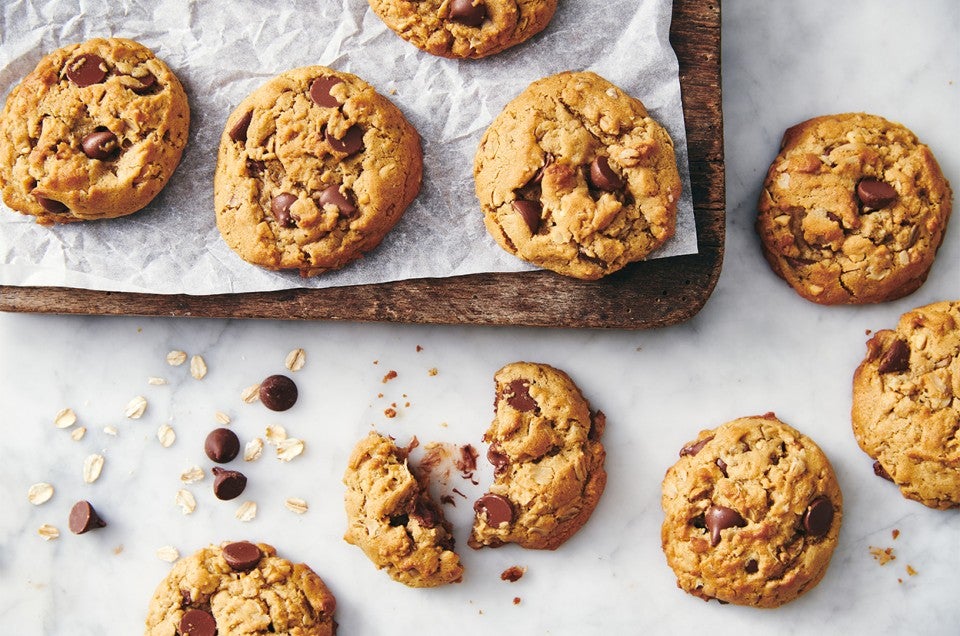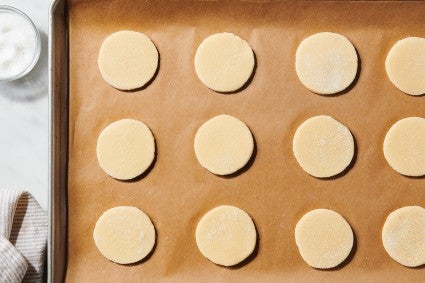Why are my cookies spreading?
Everything from your recipe to your oven may be the culprit.


 The bakers of King Arthur are here to solve the kitchen conundrums you share with us, whether it’s on the phone, computer, or by the good old postal service. In Ask the Baker’s Hotline, Annabelle will pick the brains of the talented King Arthur Baker’s Hotline team to tackle some of your most-asked questions. Today’s query: why are my cookies spreading?
The bakers of King Arthur are here to solve the kitchen conundrums you share with us, whether it’s on the phone, computer, or by the good old postal service. In Ask the Baker’s Hotline, Annabelle will pick the brains of the talented King Arthur Baker’s Hotline team to tackle some of your most-asked questions. Today’s query: why are my cookies spreading?
* * *
After taking the time to carefully cut out dozens of festive holiday cookies or scoop batches of chocolate chip-filled dough, the last thing you want to see when you pull your baking sheet from the oven is that your cookies have spread into thin, shapeless blobs. With the expert advice of cookie-pro Dawn from our Baker’s Hotline, we have the tips you need to keep your cookies from spreading.

There are many factors, both environmental and recipe-related, that can lead to your cookies spreading.
“Too much liquid or sugar can throw off your wet-to-dry ratio and lead to spreading,” says Dawn. The key to avoiding over-hydration? Measure your ingredients with a kitchen scale to ensure accuracy.
Using larger eggs than a recipe calls for can cause spreading because of the increased hydration. “Follow the size indicated in your recipe for best results,” Dawns says. “We use large eggs in all our recipes!” If you don’t know the size of your eggs, they should weigh about 50 grams each.

We’ve all thought, “Does it really matter if my butter is at room temperature?” Turns out, it absolutely does! Too-warm butter will melt and spread in the oven before your cookies set. So, if your recipe calls for room-temperature butter, it needs to be exactly that: room temperature. “It should not be melty or warm to the touch,” says Dawn. “Room-temperature butter is pliable but cool to the touch. Test it with your finger: Does it feel cool? Can you indent it but feel some resistance? If the answer is yes to both, the butter is just right.”
When was the last time you looked at the best-by date on your baking powder? “Out-of-date baking powder or baking soda will cause your cookies to spread so much that they all bake together,” explains Dawn. Because nothing is helping the cookies puff up, there’s nowhere for them to go but out!
Don't take it personally. Most ovens beep that they’re “ready” several minutes before they’re properly preheated. “Baking cookies in a too-cool oven will cause the fat to melt before your cookies set up, leading to spreading,” Dawn says. Grab an oven thermometer the next time you’re in the grocery store so you can be sure your oven is at the correct temperature.
Now that we’ve determined a few of the reasons cookies spread into unrecognizable puddles, let’s look at some ways to ensure successful future bakes.

Many cookie recipes call for butter for its unbeatable flavor. But it can come at the cost of over-spreading. “Shortening can cause cookies to spread less due to its higher melting point,” Dawn explains. “Substitute it one-for-one by volume in a butter-based cookie recipe. You can also opt for half butter, half shortening to get the best of both worlds: butter for flavor and shortening for structure.” Our Classic Chocolate Chip Cookies recipe uses both, and it’s racked up nearly 500 positive reviews. (But stick with just butter in recipes that rely strongly on butter for flavor, like our Holiday Butter Cookies or Shortbread.)
A great (and tasty) way to bring more stability to your cookies is to brown the butter. “Using cooled browned butter helps prevent spread because the water is removed during the browning process,” Dawn shares. “It also adds a unique, nutty note that boosts your cookies’ flavor profile.” When browning butter, start with a few extra tablespoons than the recipe calls for, since some of it will evaporate as it cooks. Once cooled, measure the amount your recipe calls for by weight. (If you’ve never browned butter before, here’s a step-by-step blog.)
Note that brown butter can add brown flecks (as well as a slightly nutty flavor) to baked goods. If you’re making shortbread or sugar cookies that you want to have a pure, creamy color, use regular butter.
If you really love a recipe, but it consistently spreads just a bit too much despite your best efforts, consider cutting back 10% of the sugar (by weight). As Dawn explains, “Sugar is hygroscopic, meaning it attracts liquid in cookie dough. Less sugar allows the flour to absorb more of the liquid, which stiffens the dough and helps prevent over-spreading.”

Chilling is a step called for in many cookie recipes, and it isn’t a place to cut corners. “When chilled cookies bake, the butter stays in a solid form longer, slowing the spread,” says Dawn. “30 to 60 minutes in the refrigerator does wonders, and you can bake the cookies right from the fridge.” Not only will chilling help the fats firm up and the flour hydrate, but it also helps the flavors develop. Don’t skip the fridge!
A couple of final, simple steps can be the difference between gorgeous, intricate cutout cookies and one big buttery puddle of sadness.
“For the best results, choose a silicone baking mat or parchment paper to line your pan,” Dawn recommends. “Simply greasing your pan — basically adding fat to it — will encourage your cookies to spread.” (Check out our side-by-side test baking to see for yourself.)
If you go the parchment route (which is my personal preference), be sure to reuse it! Check out our blog, Things bakers know: You can reuse parchment more than you think.

A surefire way to make cookies spread is to put them directly onto a hot sheet pan. “Thoroughly cool your sheet pans between batches,” says Dawn. “A hot pan will warm up your dough and encourage the cookies to start spreading before they even reach the oven.”
With these cookie tips in your toolbox, we guarantee the only thing spreading this season will be holiday cheer.
Not sure where to get started? Look through our full archive of cookie recipes to find your next bake.
Cover photo (Chocolate Chunk Peanut Butter Oatmeal Cookies) and food styling by Liz Neily.


